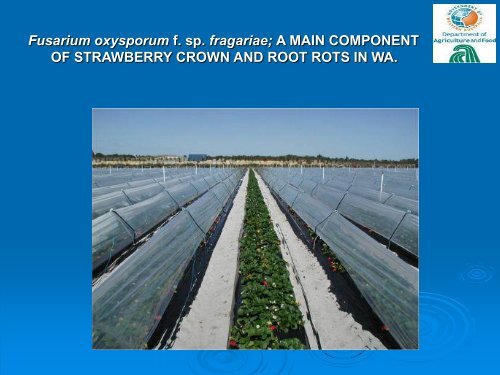Fusarium oxysporum f. sp. fragariae; A MAIN COMPONENT OF ...
Fusarium oxysporum f. sp. fragariae; A MAIN COMPONENT OF ...
Fusarium oxysporum f. sp. fragariae; A MAIN COMPONENT OF ...
You also want an ePaper? Increase the reach of your titles
YUMPU automatically turns print PDFs into web optimized ePapers that Google loves.
<strong>Fusarium</strong> <strong>oxy<strong>sp</strong>orum</strong> f. <strong>sp</strong>. <strong>fragariae</strong>; A <strong>MAIN</strong> <strong>COMPONENT</strong><br />
<strong>OF</strong> STRAWBERRY CROWN AND ROOT ROTS IN WA.
Root and crown rots are<br />
important diseases of<br />
commercial strawberry<br />
crops. Several fungi have<br />
been reported causing<br />
considerable yield reduction<br />
worldwide. The fungi,<br />
Phytophthora <strong>sp</strong>p.,<br />
Verticillium <strong>sp</strong>p., <strong>Fusarium</strong><br />
<strong>sp</strong>p. Gnomonia <strong>fragariae</strong> and<br />
Colletotrichum <strong>sp</strong>p. are<br />
known to be important<br />
pathogens. (D'Ercole et<br />
al.1989; Tezuka and Makino<br />
1991; Freeman et al. 1997;<br />
Maas 1998; Morocko et al.<br />
2006).
‣ Strawberry fields were surveyed, diseased and<br />
asymptomatic plants were collected randomly<br />
‣ Visual examination was conducted and crown of<br />
each plant was dissected lengthwise and roots were<br />
examined for disease symptoms<br />
‣ Pathogen detection from crown and root tissues,<br />
using various common and selective media.<br />
‣ Phytophthora and Pythium detection, using baiting<br />
technique<br />
‣ Pathogenicity test<br />
Material and methods
Fig. 2. F. <strong>oxy<strong>sp</strong>orum</strong> f. <strong>sp</strong>. <strong>fragariae</strong>. A, Sporodochia with monophialides<br />
macroconidia and B, Mature macroconidia. Scale bar = 25 µm<br />
A
Pathogenicity test<br />
The pathogenicity of 10 <strong>Fusarium</strong> isolates was<br />
tested on Fragaria × ananassa cv. Camarosa,<br />
Lycopersicon lycopersicum cv. Petula and Cucumis<br />
sativus (Lebanese cucumber) in a glasshouse<br />
experiment. Strawberry runners and 4-week-old<br />
seedlings of tomato and cucumber were inoculated<br />
by dipping the roots in a <strong>sp</strong>ore su<strong>sp</strong>ension ( 10 5<br />
<strong>sp</strong>ores/mL) before planting. Controls were dipped in<br />
tap water.
Isolate<br />
ID.<br />
Pathogenicity test of 10 F. <strong>oxy<strong>sp</strong>orum</strong> isolates<br />
detected from strawberry fields north of Perth<br />
Sample<br />
location<br />
Cucumis<br />
sativus<br />
Lycopersicon<br />
lycopersicum<br />
Camarosa<br />
Cv<br />
2 Site 1 NP NP P<br />
24 Site 1 NP NP HP<br />
10 Site 2 NP P NP<br />
36 Site 2 NP NP HP<br />
35 Site 3 NP NP NP<br />
43 Site 3 NP NP HP<br />
48 Site 4 NP NP P<br />
54 Site 4 NP NP HP<br />
82 Site 5 NP NP HP<br />
104 Site 5 NP NP P
Fig. 3. Phytophthora cactorum. A, Oogonia with paragynous antheridia<br />
B, Sporangiophore and <strong>sp</strong>orangia. Scale bar = 20 µm.<br />
B<br />
B
Fig. 4. Phytophthora. cactorum. Germinated and proliferated<br />
<strong>sp</strong>orangia showed by arrow. Scale bar = 20 µm.
Result: Average percentage of fungi associated with<br />
root and crown rots of Camarosa cultivar<br />
Recovered Fungi<br />
Total recovery %<br />
Diseased<br />
Healthy*<br />
Crown Roots Crown Roots<br />
<strong>Fusarium</strong> <strong>oxy<strong>sp</strong>orum</strong><br />
f. <strong>sp</strong>. Fragariae 74.0 20 4.0 1.0<br />
Phytophthora <strong>sp</strong>p. 21.0 5.0 1.5 0.5<br />
Pythium <strong>sp</strong>p. 8.0 18 5.0 8.0<br />
Phoma <strong>sp</strong>p. 3.3 1.0 0.0 0.0<br />
Rhizoctonia <strong>sp</strong>p. 4.3 9.0 2.0 4.0<br />
Colletotrichum <strong>sp</strong>p. 1.5 1.0 0.0 1.0<br />
Macrophomina <strong>sp</strong>p. 4.0 12 1.0 0.5<br />
Others 7.0 5.0 2.0 4.0
Conclusion<br />
Result of the tests and consistency of the isolated<br />
fungi, indicated that <strong>Fusarium</strong> <strong>oxy<strong>sp</strong>orum</strong> f. <strong>sp</strong>.<br />
<strong>fragariae</strong> is a main component of strawberry<br />
crown and root rots, however combination of<br />
isolated fungi may have been involved in crown<br />
and root rot complex.
ACKNOWLEDGMENTS<br />
I would like to thank Dennis Phillips and<br />
Sandra Mack for their support and technical<br />
assistance and WA. strawberry industry for<br />
financial support.






![[Compatibility Mode].pdf](https://img.yumpu.com/27318716/1/190x135/compatibility-modepdf.jpg?quality=85)









